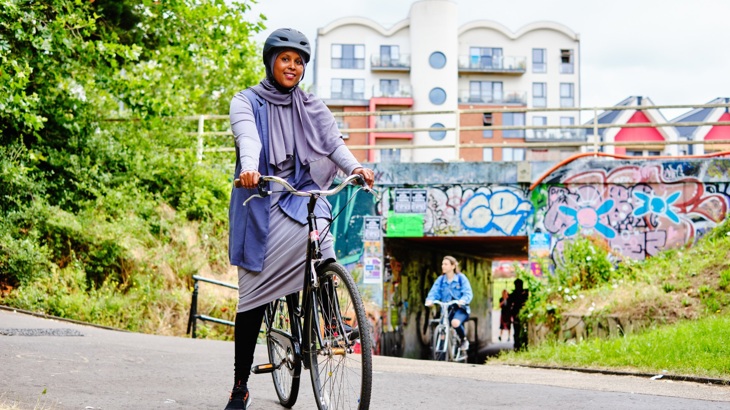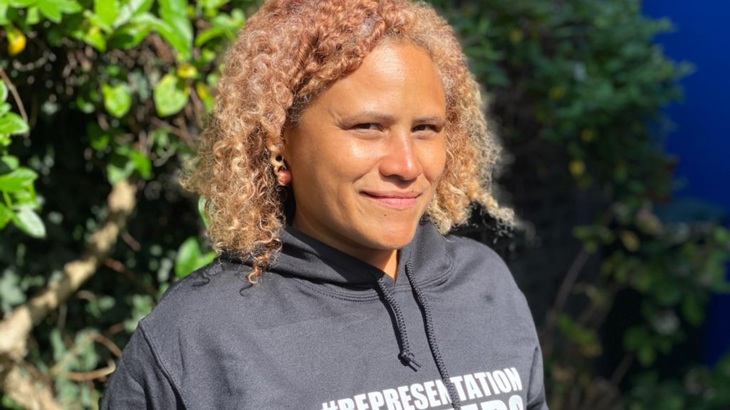Zoe Banks Gross, our Head of Partnerships and Public Affairs for South of England, looks at the bias of our built environment. She discusses how it can be a barrier to walking, wheeling and cycling for women and girls.

Women and girls are less likely to choose active travel than men and boys.
Even before the Covid-19 pandemic, more than twice as many men (21%) said they cycled at least once a week versus the 9% of women who did (Bike Life, 2019).
Both UK and global figures show that more women than men fail to meet the minimum activity guidelines, usually by three or four percentage points (Peter Walker, The Miracle Pill).
Recent data shows that 40% of adults between 40-60 (my demographic) didn’t even get a 10-minute brisk walk in during the last month.
Whether on the couch or in a car, health experts are concerned that our lifestyles are becoming so sedentary that it is dangerous.
Is it simple for everyone to make the right choice?
It’s easy in many cities to drive your car to work, to the shops, or to do the school run, even though these distances may be well within a 20-minute walk.
But the last two years of the pandemic have shown us how important it is for our physical and mental health to move around and get enough fresh air.
It’s also shown us how quickly we can shift our usual ways of life if we need to.
The initial lockdown resulted in fewer cars on the roads and a massive uptake in cycling and walking.
I saw people out on my local roads and paths with their families, people that I had never seen outside of a building before.
But as things have shifted back to more vehicles on the road, many people have reverted to pre-pandemic habits.
Not enough people are getting out enough to walk, wheel or cycle, and this is particularly true for women.
The built environment is biased
A reason for this gender difference is that, in the UK, the public realm is often biased in its design.
Spaces do not always accommodate women, who are often looking after young children or the elderly.
Our cities and towns have been designed by and for those who have held power, usually men (Peter Walker, The Miracle Pill).
For example, cycle lanes and spaces have historically been designed for a man riding single file on a road bike, instead of a parent riding next to their children or using a trailer or cargo bike.
Busier roads – usually the most direct routes – are less appealing areas for women, especially those with caring responsibilities.
It can be intimidating for people less confident on bikes to use these spaces.
This is especially true if they do not fit the expected mould of male, white, lycra-clad and on a road bike.
The issue of personal safety is often overlooked in planning for walking, wheeling and cycling, and it’s one that disproportionately affects women.
Traffic-free cycling and walking paths are not always well-maintained and may have poor lighting or overgrown vegetation.
It therefore seems no surprise that the biggest reported barrier to cycling is safety – 47% of respondents said this kept them from cycling more.

The way our spaces are designed can make it particularly difficult for visible minority ethnic women to feel confident cycling.
Feeling entitled to use spaces
I have a lot of experience teaching visible minority ethnic women and girls to cycle.
I’ve found that, even when they gain confidence on their bike, it can be hard to convince these women and girls that they are entitled to use this space, just like those they see dominating it.
Whether taking a primary position in the road or using some of the traffic-free routes available, women need more validation in taking up these spaces, especially if they come from minority backgrounds.
Making walking and cycling more accessible to all
This work takes into consideration what local communities want and how these spaces can be harmonious.
Although the Department for Transport has recently produced guidance on design for cycle infrastructure, there is a lot of work to do to realise this.
And whilst it is great that these standards exist for cycling, we also need to be able to walk easily around our cities and towns.
In some places, this may be possible, but it’s certainly not pleasant.
Making towns and cities inclusive
Advocates for walking speak of the five Cs: connected, convivial, conspicuous, comfortable and convenient (Tim Gill, Urban Playground.)
Most cities in the UK do not have many public spaces which tick all of the above.
The C of conspicuous, relating to the visibility and safety of spaces, is one that’s particularly relevant to women and people from ethnic minority backgrounds.
Changes to the built environment therefore need to be designed for and by the people who will use them, or who would like to start using them.
How we can break the bias
There are two ways we can break the bias and create equitable change.
The first is to involve community members in decisions made about their local area.
At Sustrans, we use the idea of co-design – actively seeking out participation from residents, businesses or stakeholders – when developing or changing spaces.
This approach means the people who get around actively in these spaces – and those who’d like to start – can have a say in how they’re created.
Another way we can break the bias is to encourage more women and people from ethnic minority backgrounds into professions like landscape architecture, urban design, planning and engineering.
This would mean that plans and decisions at the earliest stage come from a wider cross-section of our society.
Bringing people into these professions who have backgrounds or perspectives different to the norm will allow the industry as a whole to meet everyone’s needs and create future spaces which are less biased and more equal.
Read about some of the work we're already doing to make it easier for women and families to cycle.

About the author
Zoe Banks Gross is passionate about social justice, sustainability and public health.
She’s the Head of Partnerships and Public Affairs for the South of England at Sustrans.
She’s involved at the grass roots level addressing health inequalities and making her community more sustainable.
In 2014 she founded East Bristol Kidical Mass and began teaching women and kids to cycle.
Zoe wants to see more women and girls walk, run, cycle and take up space in the outdoors.






